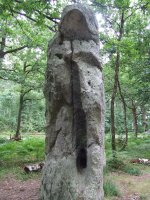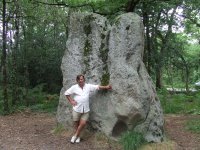Going back to who were the ancient Brits, have been reading around on it - quite confusing as thinking on it keeps changing.
I've found this timeline on Quora, so written by a random, but I think represents current thinking (I added Cro-Magnon to it)
How people looked is disputed, but Im enjoying the scientific DNA modelling speculation so sticking in some pictures
Also have been reading up about the "Celtic" wave of migration and how its basically disowned as a major genetic event (as mentioned above), lots of articles out there on it, such as
Myths of British ancestry - suggesting Iberia and particularly Basque area dominant right up to Roman invasion with a small mix of northern europeans occuring in pre-Roman times
Cro-Magnon
30,000BC>>>>
Cro-Magnon man, "a group of homo-sapiens who succeeded the Neanderthals in Europe. This representation was based on a skull that was found in France, but Cro-Magnons also lived in England from about 30,000 to 10,000 years ago.
The work of Nilsson indicates that he had a very dark complexion and was darker than many modern North Africans. "
Ice Age Hunter-Gatherers
10,000BC>>>>
During the last Ice Age, about 11–12,000 years ago, when the ice was receding and sea levels were lower, there was a land bridge that was exposed that connected Britain with mainland Europe. The Hunter-gatherers crossed this bridge and started what would be the first continuous settlement of the British Isles.
These people are the ancestors to a skeleton found in Cheddar Gorge in Somerset, England, named Cheddar Man. These people had dark-brown/black skin, blue/green/hazel eyes and were dark haired. 10% of British ancestry can be traced to Cheddar Man. The biggest cluster of this ancient DNA can be found in Northern Wales, although there have been links in Somerset as well, amongst people local to where Cheddar man was found.
" Cheddar Man has the genetic markers of skin pigmentation usually associated with sub-Saharan Africa. "
or maybe didnt
The headline was that an ancient Briton from 10,000 years ago had dark skin, but the genetics of skin colour are so complex that we can’t be sure

www.newscientist.com
First Wave of Migrants - "Iberian Farmers" - (most responsible for megalithic structures on this thread if I've understood it right)
4,000BC>>>
About 6,000 years ago, a new wave of migrants, who were mostly farmers, came to Britain from the Mediterranean (These peoples ancestors came from what is today Turkey). They were roughly brown skinned, brown eyed and had dark hair.
At this point, Britain was now an Island, as the land bridge had been submerged by partially by rising sea levels, but also due to a tsunami, caused by underwater landslides near Norway. The tsunami hit the East coasts of what is now Scotland and England.
The incoming migrant population was larger than native population, and they bought new technologies to Britain. Their farming lifestyles are known because samples of sediment showing preserved pollen, and in areas they farmed, it can be seen where they cut or chopped plants and trees and replaced them with crops like wheat, simply by seeing in change in pollen.
How the incomers communicated or interacted with the original inhabitants is not known, but eventually the incoming Iberian population would largely replace the original inhabitants, although considering the native population was much smaller than the new arrivals and 10% of original inhabitants DNA still remains a part of British ancestry then it is very likely genocide wasn't the cause. I assume the reason is probably disease and that the original population, at first, isolated themselves, then eventually over time became integrated with the new arrivals. Either way, the new arrivals began a new era for Britain; the Neolithic Period.
Second Wave; The Beaker People
2,400ishBC>>>
About 4,400 years ago, Britain would again get a new wave of migrants, referred to as the Beaker People, known for their use of pottery, with many of their burials having included pots as well. The Beakers came from Continental Europe (Germany, Switzerland, etc), and their ancestors were from Eurasia. They were much lighter coloured than the previous migrants to Britain, lighter skin colour, eye and hair colour as well.
Ironically just like the Iberian migrants before them, the beaker people, after a few centuries after they arrived, replaced the British gene pool by 90%. Again, like the preceding migrants, instead of it being genocide or fighting, the most likely reason was diseases which were devastating for those who had been isolated for almost 2000 years. They too bought new technologies to Britain and it ended the Neolithic Period, and started the Early Bronze Age. Also, most people in the British Isles are descended from these migrants.
(According to this though this person from the Beaker era at least " had a more Mediterranean complexion [than expected], and was lactose intolerant. ") - with her parents originating from the Netherlands
New DNA evidence drastically changes the image of the young woman buried in Caithness 4,250 years ago

www.smithsonianmag.com
Bronze Age: Economic Trade with Europe
2500BC - 800BC
The Bronze Age saw the increase in trade with Europe. Resources and minerals were extracted; Bronze, Copper, Tin, even Gold, were used to make swords, jewellery and other stylish goods to trade overseas. This seemed to have continued til the Iron Age.
Other than the Beakers, there does not seem any major migrations or invasions.
Iron Age; The ‘Insular Celtic’ Languages
800BC - 43AD
The significant use of Iron tools bought about a period of time we know as the Iron Age. The peoples, in this time, in the British Isles starting living in tribal societies and adopted a common language that is referred to as Brittonic. This period of time saw the increase in use of animal husbandry and a pagan belief system across Britain. Because of increasingly densely populated areas in the South, many tribes came into conflict with each other.
There seems to have been some influx of people from the continent, such as the Belgae in Southern Britain, possibly the Atrebates; a tribe who shared a similar name to a tribe in Gaul, and possibly Iberian farmers into Western Britain, although that is disputed.
Early Iron Age saw a decline of economic trade with Europe, although imports were still coming into Britain. Trade picked up again Mid-Late Iron Age, it is believed that Gauls may have asked for aid from Britain in their fight against Rome. When Gaul was conquered, there was, once again, an increase in trade between South-Eastern Britain and the Continent. At this point, Britain was known to traders as far south as Greece and Mediterranean for being rich in resources.
The Iron Age came to an end with the Roman Invasion of Britain.
So basically you have:
- Ice Age Hunter-Gatherers
- Mediterranean Farmers
- Central European Beaker People
- Small Gallic-Germanic Celtic influx
- Romans (Most likely used Germanic peoples as soldiers, so difficult to know if the Romans added to the British Gene pool)
- Anglo-Saxons in SE Britain, and Gaels in West Caledonia and some coastal parts of Wales.
- Danish Vikings in England (Came from the same region as the Anglo-Saxons, so difficult to know how much the Anglo-Saxon contribution to the English gene pool is actually due to the Anglo-Saxons, and how much is due to the Danes). Norwegian Vikings in Northern Scotland (Because the Norwegians invaded the Isles, where the population remains limited and being less exposed to immigration, means their contribution to the local gene pool is more recognisable).
- Normans (Including some Breton followers) in Southern Britain (Conquest of England in 1066, Subjugation of Wales).














 :seeks solace in the eternal stones:
:seeks solace in the eternal stones:

















